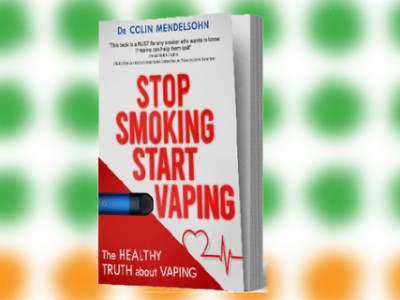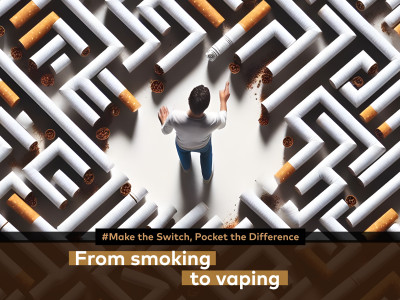The paper starts by reaffirming some given facts and received opinion:
- Electronic cigarettes are a recent addition to the bank of measures open to current smokers.
- Usage has grown very rapidly and now many millions of people use 1st, 2nd and 3rd generation devices across the world.
- Electronic cigarettes offer an ideal opportunity for smokers to quit smoking and that stopping smoking altogether is the perfect aim of any nicotine replacement delivery system.
- The two biggest problems smokers face when trying to quit are a) the addictive nature of nicotine and b) breaking the habit of how and when smokers smoke.
- 6,000,000 smokers die from their addiction every year and that it is predicted that around one billion smokers will die during the 21st century (World Health Organisation statistics).
- All of the 4,000+ chemicals and carcinogens contained in cigarette smoke are absent from the vapour produced by e-liquid because there is no combustion.
- It is these chemicals and carcinogens in cigarette smoke that leads to smoking-related death and therefore vaping is safer because it doesn’t contain them.
Farsalinos and Polosa point out that e-cigs offer “much safer sources of nicotine” compared to smoking. Plus, given that the success rate for traditional forms of nicotine replacement therapies (NRT) such as gum and patches is only 2% (Department of Health statistics), Farsalinos and Polosa recognise that “since their (e-cig) invention in 2003, there has been constant innovation and development of more efficient and appealing products.”
Farsalinos and Polosa looked at forty-one studies into e-cig safety and included studies into the safety of e-liquids and presentations made by leading medical professionals to conferences making a total of 141 sources.
Many doctors mistakenly believe that nicotine can cause the heart to malfunction or for blood to clot causing heart attacks and strokes. Farsalinos and Polosa use thirty-five pieces of research to support their case. The research they looked at concluded that nicotine does not limit the function of heart cells and does not promote red blood cells to clot.
Nicotine poisoning from vaping is almost impossible to imagine, as vapers tend to stop vaping once a craving for nicotine has been met – especially when they begin to feel dizzy or develop a headache.
Regarding flavourings, Farsalinos and Polosa conclude that there is no current understanding of the long-term effect of vaping the flavours but that all current data shows very tiny amounts of toxins, so small they are either insignificant or of such a level they are far, far less than that found in cigarettes. In particular, they cite a study this year carried out by Burstyn that says “No evidence of levels of contaminants that may be associated with risk to health.”
They cite that 2009 study carried out by Laugesen, supported by the findings from Kim and Shin in 2013, showed the relative levels of cancer causing nitrosamines in e-cigs was approximately equal to that found in NRT gum…and around 1,000 to 1,800 times less than the levels found in cigarettes.
Farsalinos and Polosa summarise that, regarding passive/second-hand vaping, there are few studies in this area…but, firstly the effects are minimal (implied from the findings into what vapour is made up of) and secondly this is supported by the findings of research carried out by McAuley and colleagues into indoor air quality.
Regarding the use of e-cigs with people suffering from mental health issues demonstrated no deterioration in their mental health and that e-cigs could be very useful in helping to quit smoking, especially as traditional forms of NRT have been shown not to work well at all with this sector of smokers.
Reference is made to safety issues, such as accidental fires, but they state this is as likely to happen with any other similarly powered product within the home and that it comes down to the manufacturing quality of the individual device and being used in a correct fashion.
Farsalinos and Polosa conclude that a lot of scientific research has been misquoted and/or misrepresented by politicians and health commentators, that the potential for harm has been greatly exaggerated, that the e-cig presents a much safer way of accessing nicotine than smoking and also helps to prevent someone going back to smoking.
Photo Credit:
Image by mohamed Hassan from Pixabay
Toby Kilroy
Journalist at POTVToby has been vaping since early 2012 and has used an array of devices and kit in that time. He sometimes writes up reviews but is often found with his head stuck in pages of code with a confused smile on his face. Toby also helps run his wife's site gethistory.co.uk and has two children. He sometimes fondly remembers having free time and occasionally manages to sneak away to put his head into a good book!
Join the discussion
Mexican Ban is Unconstitutional
Mexico's Supreme Court has declared the government’s ban on vaping to be unconstitutional and the verdict has been welcomed by the World Vapers' Alliance
The Healthy Truth is Free
Dr Colin Mendelsohn’s book detailing “the healthy truth about vaping” is now available as a free PDF download from his website
Ministers Attack Vaping
Ministers attacked vaping in a Backbencher Business debate on Electronic Cigarettes led by Conservative Dr Caroline Johnson – who has become a vocal opponent to tobacco harm reduction
CDC Still Needs To Get It Right
United States public health officials at the Centres for Disease Control still need to correct e-cigarette health misinformation, according to a group of experts












